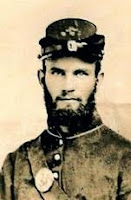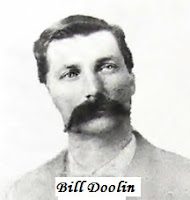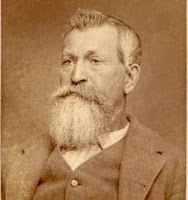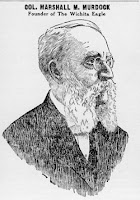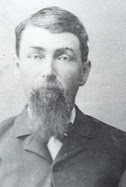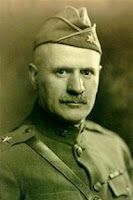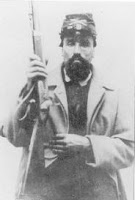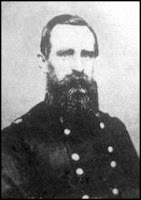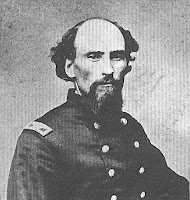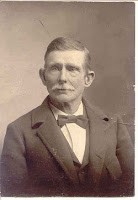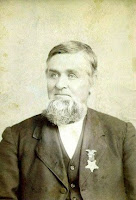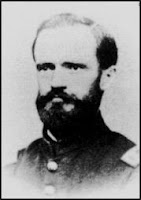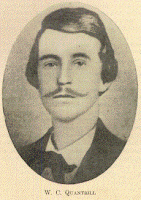These Kansas men were at the reunion of the Grand Army of the Republic, of 1881. ---------------------------
1. William C. Bryant, private, 7th., Kansas cavalry Co. H., enlisted Dec. 10, 1861, mustered in same day, home Stanton,, was promoted Saddler, would reenlist as a Veteran on Jan.1, 1864. Mustered out with regiment September 29, 1865.
2. Joseph S. Hill, private, 7th., Kansas cavalry, Co. A., enlisted on Sept. 6, 1862, mustered in same day, home Plymouth, Mustered. out on det. roll, St. Louis, Mo. Nov. 30, 1864.
Joseph S. Hill, was born May 21, 1835, died on Aug. 3, 1895. Burial Pleasant Valley Cemetery, Winfield, Cowley County, Kansas.
3. H. W. Stubblefield, Captain, Kansas 16th. Cavalry, Co. H, enlisted on April 2, 1864, home Elizabetht'n. Mustered out with regement Dec. 6, 1865.
4. James H. Finch, private, Kansas 13th., infantry, Co. D., enlisted on Aug. 21, 1862, mustered in on Sept. 19, 1862. Home Atchison. Promoted Sergeant on Sept. 19, 1862, then promoted to First Sergeant on March 12, 1863. Mustered out with regiment on June 26, 1865.
James H. Finch, was born in 1833, died on May 10, 1885.
He lived for a time in Illinois, then in Kansas, where Mr. Finch enlisted in 1862 in Atchison in Company D, 13th Regiment Kansas Volunteers. He was first sergeant of the company, served in the Army of the Frontier under Gen. Blunt, was in several battles, but never wounded. He received a lieutenant's commission, but owing to the close of the war did not muster on it; was discharged in Little Rock, Ark., June 26, 1865. He returned for a time to Atchison, finally settling in Winfield, Kan., where Mr. Finch was deputy sheriff of the county and U. S. marshal, which office he held at the time of his death. He was also senior vice commander of his post in Winfield and was buried with military honors. He died May 10, 1885. More can be read about him and his wife at the site of ( Find a Grave. )
5. John W. Sparks, private Kansas 2nd., cavalry Co. D, enlisted on Dec. 10, 1861, mustered in same day home Marysville. Prisoner of war, capt'd at Muzzard Prairie, Ark., May 22, 1864; no evidence of must. out on file.
John W. Sparks was born on Jun. 11, 1838, Sangamon County, Illinois. Died on Jul. 13, 1900, Ringwood, Major County, Oklahoma.
John Wesley Sparks enlisted as a Private in the Union Army on 10 December 1861. He was twenty-three years old at the time of his enlistment. He listed his residence as Marysville, Kansas. John Wesley Sparks served three years in the Union Army during the Civil War. He entered the Union Army at Fort Leavenworth, Kansas. John Wesley Sparks served as a Private in Company D, 2nd Regiment of the Kansas Cavalry. His commander was John A. Lee. The 2nd Kansas Volunteer Regiment of Union Cavalry was organized at Kansas City as the 12th Kansas Infantry. At Fort Leavenworth, Kansas their designation was changed to the 9th Kansas Infantry on February 4, 1862, and later to the 2nd Cavalry on March 5, 1862. More information and photo can be found at the site of ( Find a Grave.)
6. J. C. Clarey, Reg. 12, Co. K, Private.
Couldn’t be found on the roster name must had been spell wrong.
7. Thomas M. Williams, private, Kansas 2nd., cavalry, Co. I, enlisted on Aug. 29, 1863, mustered in on Aug. 13, 1863, home Blooming Grove. Assigned to new Co. C, March 18, 1865. Mustered out June 22, 1865, Fort Gibson, C. N.
8. Enoch Henson , private, Kansas 5th., cavalry, Co. D. enlisted on Aug. 23, 1861, mustered in on Feb. 11, 1862, home Fort Scott. Mustered out Sept. 5, 1864, Leavenworth, Kan.
Enoch Henson was born Mar. 20, 1844, Lawrence County, Missouri. Died on Sept. 15, 1900. Burial Dexter Cemetery, Dexter, Cowley County, Kansas.
9. Wm. Jones, Reg. 15, Co. K, Private.
There is no rosters for the regiment.
10. James Kinsey or Kenzey, private Kansas 5th., cavalry Co. I., enlisted on Nov. 14, 1861, mustered in on Feb. 7, 1862. Disc. for dis. December 8, 1862, Helena, Ark.
11. T. W. Tharp, Reg. 2, Co. F, Private.
Couldn’t be found on the rosters.
12. Amos Walton, private, Kansas 9th., cavalry Co. B., enlisted on Oct. 12, 1861, mustered in same day. Promoted Quartermaster Sergeant June 13, 1862. Mustered out Nov. 19, 1864, Leavenworth Kan.
Amos Walton, born 1838, died in 1898, Burial Riverview Cemetery, Arkansas City, Cowley County, Kansas.
13. Nathan W. Dressie, private, Kansas 8th, infantry Co. C, enlisted on Jan. 26, 1861, mustered in same day, home Hometown. Re-enlisted Veteran, Feb. 27, 1864. Disc. Jan. 20, 1865, Leavenworth, Kan., on account of wounds received in action July 23, 1864.
14. John N. (W?). Powell, private, Kansas, 12th., infantry, Co. D,, enlisted on Aug. 30, 1862, mustered in on Sept. 25, 1862, home Shermanville. Dis. for dis. May 18, '63, Leav'th.
15. Joseph Powell, Reg. 6, Co. H, Private.
Couldn’t not be found on the rosters.
16. Walter Scott Williamson, private, Kansas 9th., cavalry Co. C, enlisted on Sept. 8, 1861, mustered in on June 30, 1863, home Ottumwa. was promoted to Corporal then Reduced to ranks. Mustered out Nov. 21, 1864, Leavenworth, Kan.
Walter Scott Williamson, was born Mar. 16, 1833, Michigan, died Jun. 9, 1905. Wife was Frances M. Williamson married 1866. Burial Dexter Cemetery, Dexter, Cowley County, Kansas.
17. Dempsey Elliott, private, Kansas 9th., cavalry Co. C.
Couldn’t be found on any rosters.
